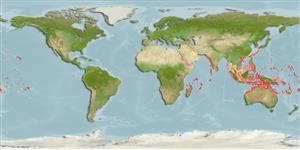Common names from other countries
Environment: milieu / climate zone / depth range / distribution range
экология
морской ассоциированный с рифами; пределы глубины 30 - 50 m (Ref. 1602). Tropical; 32°N - 24°S, 30°E - 145°W
Indo-Pacific: Red Sea to East Africa, through northern Australia to Society Islands, north to southern Japan.
Size / Вес / Возраст
Maturity: Lm ? range ? - ? cm
Max length : 55.0 cm TL самец/пол неопределен; (Ref. 9770)
колючие лучи спинного плавника (общее число) : 3; членистые (мягкие) лучи спинного плавника (общее число) : 24 - 27; колючие лучи анального плавника: 0; членистые (мягкие) лучи анального плавника: 19 - 24. Dark brown, scales with yellow spot; pectoral, soft dorsal, anal and caudal fins dark with yellow margins; juveniles yellowish brown with bluish grey spots and blotches (Ref. 4420). Juveniles under about 5 cm, tan with dark saddles and numerous dark wavy lines on the body. Larger juveniles loose the dark saddles and become covered in a network of brilliant blue lines which become increasingly interconnected with growth (Ref. 37816).
Occur in clear shallow lagoons and seaward reefs; sandy areas near reef patches of reef edge are preferred. Adults on deep reefs or with shipwrecks, usually deeper than 30 meters. Juveniles inshore on rubble reef or small outcrops on open substrate (Ref. 48637). Feed on sea urchins, crustaceans, mollusks, dead fish, tunicates or corals (Ref. 5503). Oviparous (Ref. 205). Monogamous (Ref. 52884). Also caught with drive-in nets. Marketed fresh and dried-salted (Ref. 9770).
Life cycle and mating behavior
Maturities | размножение | Spawnings | Egg(s) | Fecundities | личинки
Distinct pairing (Ref. 205). Nest-guarding females are aggressive (Ref. 9770). Females are territorial, solely tending and guarding the eggs. Males exhibit polygyny (Ref. 116451).
Myers, R.F., 1991. Micronesian reef fishes. Second Ed. Coral Graphics, Barrigada, Guam. 298 p. (Ref. 1602)
Статус Красного Списка МСОП (Ref. 130435)
CITES (Ref. 128078)
Not Evaluated
Угроза для людей
Harmless
Использование человеком
рыболовство: коммерческий; аквариум: коммерческий
дополнительная информация
инструменты
Специальные отчеты
Скачать в формате XML
ресурсы в Интернет
Estimates based on models
Preferred temperature (Ref.
115969): 24.7 - 28.4, mean 27.5 (based on 138 cells).
Phylogenetic diversity index (Ref.
82804): PD
50 = 0.6250 [Uniqueness, from 0.5 = low to 2.0 = high].
Bayesian length-weight: a=0.03548 (0.02074 - 0.06071), b=2.94 (2.79 - 3.09), in cm Total Length, based on LWR estimates for this species & (Sub)family-body (Ref.
93245).
Trophic level (Ref.
69278): 4.0 ±0.0 se; based on diet studies.
устойчивость к внешним воздействиям (Ref.
120179): средний (среднего размера), минимальное время удвоения популяции 1.4-4.4 года (Preliminary K or Fecundity.).
Fishing Vulnerability (Ref.
59153): Moderate vulnerability (42 of 100).
